Art & Exhibitions
David Ebony’s Top 10 New York Gallery Shows for March
Atta Kwami, Ericka Beckman, and Xavier Veilhan are in the mix.
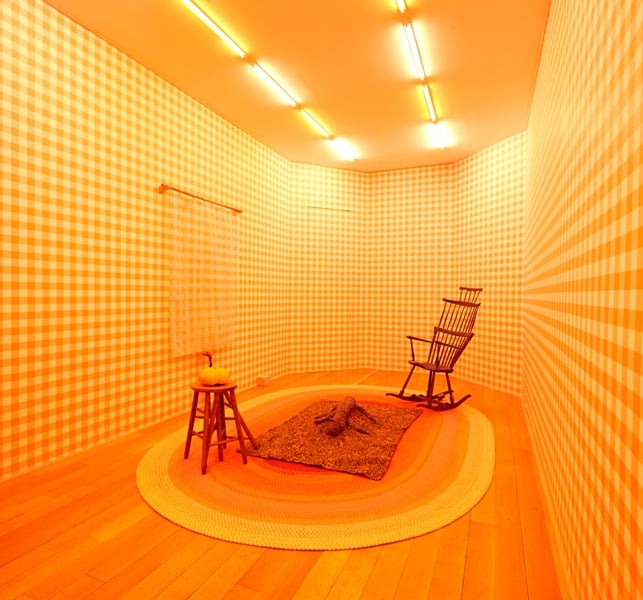
Image: Courtesy Luxemburg & Dayan
Atta Kwami, Ericka Beckman, and Xavier Veilhan are in the mix.

David Ebony

1. Alex Da Corte at Luxembourg & Dayan, through April 11.
Die Hexe, an elaborate and evocative installation by 35-year-old Philadelphia-based artist Alex Da Corte occupies the entire exhibition space on three floors of this Upper East Side townhouse gallery. Each room is vastly different in character and mood, yet each has a similarly palpable intensity. The work’s title means “The Witch” in German, and the place indeed suggests a scary haunted house, offering a truly “surround audience” kind of experience. The eerie foyer, dimly lit by flickering electric candles, sets the tone.
In preparation for this work, Da Corte researched the gallery building and discovered that it was once occupied by the iconic 1960s quartet the Mamas and The Papas. He used this bit of pop trivia to imaginatively explore the idiosyncrasies of his own ancestry. Each room alludes to some aspect of the life of a parent or grandparent. The house, though, is haunted primarily by art or, rather, the ghosts of artists past and present. One garishly lit room in searing bright orange, for instance, contains an actual Mike Kelley stuffed-animal-and-blanket floor sculpture, while in other rooms, visitors encounter works by Haim Steinbach, Robert Gober, Bjarne Melgaard, and others, gracefully ensconced in Da Corte’s installation. (For a more in-depth review of this show see Alex Da Corte’s Twisted Installation at Luxembourg and Dayan Channels Blue Velvet and Pee Wee’s Playhouse.)
If you go, try to make it on a weekday; as word gets out about this extraordinary show, the limited number of visitors allowed into the gallery at one time is likely to result in long lines on Saturdays.
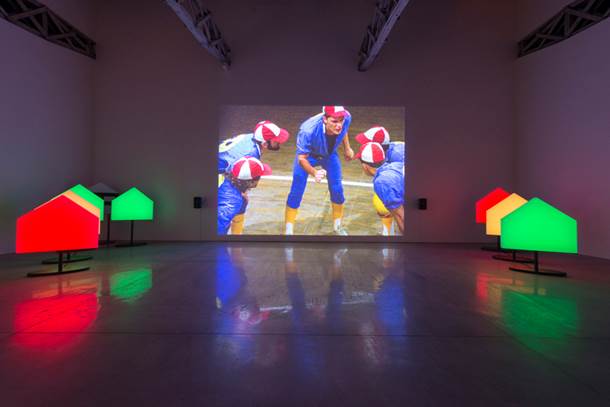
Installation view, Erica.Beckman, You the Better (1983-2015).
Photo: Courtesy Mary Boone Gallery.
2. Ericka Beckman at Mary Boone, through April 25.
This high-energy exhibition of work by New York filmmaker and installation artist Ericka Beckman features a large-scale video projection of You the Better, a 1983 film that debuted at the New York Film Festival in 1984. Organized by former Swiss Institute curator Piper Marshall, the show includes for the first time Beckman’s large-scale sculptures created to accompany the film, made of brightly colored translucent Plexiglas. Illuminated from within, these softly glowing objects resemble abstracted houses, and giant game-board pieces; they correspond to similar shapes that appear in the film. The sculptures, combined with a riveting soundtrack of electronic sounds, rhythmic beats and choral chants, contribute a great deal to the overall visceral power of the installation.
Beckman has often used the motif of games, particularly games of chance, as a means to explore issues of social order, societal rules and hierarchy, not to mention the psychology of aggression and competition. You the Better shows teams of uniformed players engaged in a strange kind of ball game. Their frenetic movements seem carefully choreographed as the players throw the ball at given targets: colorful, five-sided polygons related to the sculptural forms occupying the gallery space. In this novel and exciting integration of sculpture and video, in which the filmed images seem to extend into the space of the gallery, You the Better inevitably pulls the viewer physically and mentally into the game.
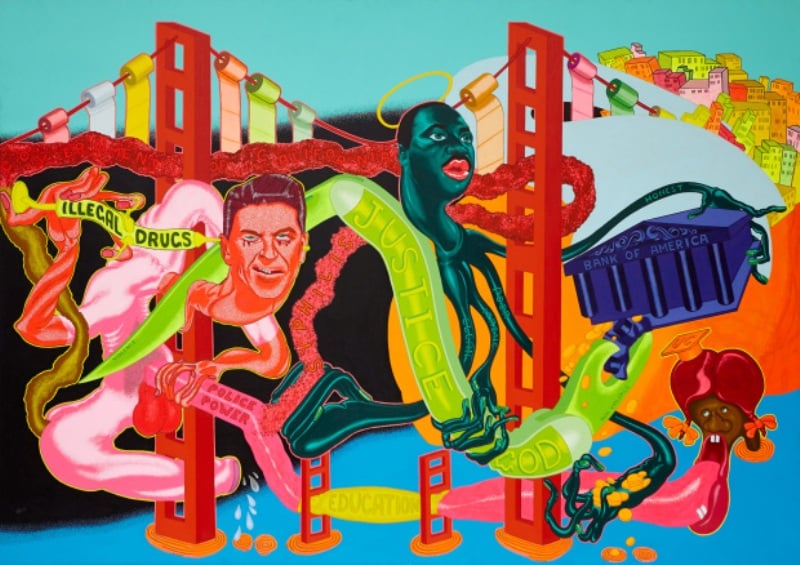
Peter Saul, The Government of California (1969).
Photo: Courtesy Venus Over Manhattan.
3. Peter Saul at Venus Over Manhattan, through April 18.
“Peter Saul: From Pop to Punk” is a stunning, museum-quality survey of Peter Saul’s early work, from 1961 to 1973. The twenty-one major paintings and large works on paper on view are rarely exhibited pieces from the estate of Saul’s long-time dealer Allan Frumkin. And many of them may be counted among the best and most provocative works of the San Francisco-born New York artist’s long career. Right from the start, Saul was not out to please art audiences. His early work has a consistently acerbic edge and a raw and fearless political stance in which no subject matter seemed to be off limits.
Paintings such as Sex Boat (1961), and Superman and Superdog in Jail (1963), place Saul at the forefront of the early Pop art movement, since they feature cartoon imagery and schematic figurative elements executed with painterly panache. While these works address the American vernacular with tongue-in-cheek humor, they appear as send-ups of the Ab Ex tradition that dominated painting of the previous decade. As the 1960s progressed, Saul’s palette became increasingly caustic, as he favored hot pinks and acid greens, and his painting and drawing style grew more refined.
His imagery, too, became increasingly outrageous while he aimed for a new kind of cartoon-inflected, epic history painting. A number of works, such as Human Dignity (1966) and Pinkville (1970), for instance, constitute ferocious protests against the Vietnam War. In The Government of California (1969), Saul tackles corruption in his home state, with an image that features a sardonic portrait of then-governor, and future U.S. president, Ronald Reagan. I imagine that Saul’s paintings were difficult for most people to look at, let alone appreciate, when they first appeared. Today, they seem masterful and of-the-moment, well attuned to the Zeitgeist of our time.
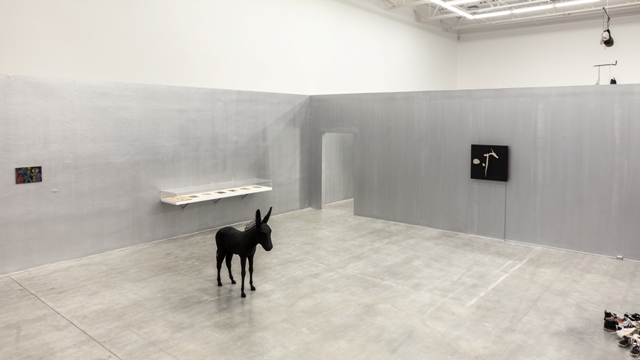
Installation view, “Work Hard,” 2015, curated by Valentin Carron.
Photo: Courtesy Swiss Institute.
4. “Work Hard,” curated by Valentin Carron, at the Swiss Institute, through May 24.
In his curatorial debut, Swiss artist Valentin Carron, who represented Switzerland at the 2013 Venice Biennale, presents “Work Hard,” a compact and compelling overview of contemporary Swiss art (see Venice Biennale Curator Okwui Enwezor On “All the World’s Futures”). The show’s title refers to the fabled Swiss work ethic, as well as to a graffiti scrawl Carron saw on a public sculpture in Lausanne. This particular story of recent Swiss art trends is told from a very specific point of view, a kind of eccentric, neo-Dada vision that reflects Carron’s own quirky sculptures and installations. Visitors circulate through the exhibition in custom-designed rooms lined with silver walls, echoing Warhol’s “factory.” The show contains engaging works by Ugo Rondinone, Urs Luthi, Fabrice Gygi, and others.
A black-painted plywood and rattan donkey, Black Balthazar, by Mai-Thu Perret, makes for an intriguing show opener, positioned at the exhibition’s entryway near one of Claudia Comte’s small Arp-like modernist wood sculptures placed on a low shelf. A motorized black-and-white wall relief by Jean Tinguely, hung on the rear wall of this room, is just one of several historical pieces, including works by Daniel Spoerri, Luciano Castelli, and Meret Oppenheim, that Carron has selected in homage to his artistic forebears.
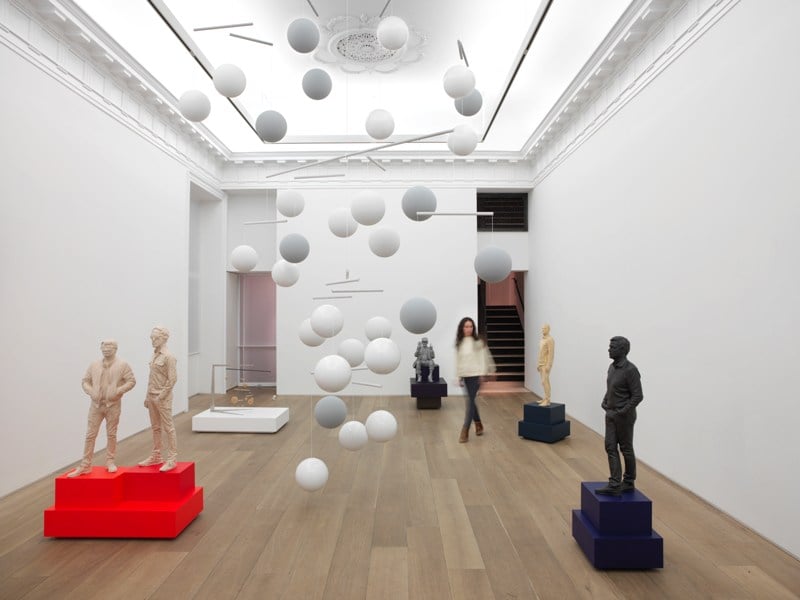
Installation view, Xavier Veilhan, “Music,” 2015.
Photo: Courtesy Galerie Perrotin, 2015.
5. Xavier Veilhan at Galerie Perrotin, through April 8.
Over the course of the past decade or so, Xavier Veilhan has established an international reputation for an idiosyncratic and complex ontology using a wild range of styles and mediums, encompassing sculpture, installation, painting, photography, and performance. It is hard to get a sense of the scope and range of his work in this tightly focused show, titled “Music,” but it is brilliant nonetheless.
The two-part exhibition (the second half is concurrently on view at Galerie Perrotin in Paris) centers not on sound but on music producers themselves. Veilhan used 3-D digital processes to capture full-length likenesses of some prominent music producers today, which he transposes into realist-style statues in wood and resin. These sculptures, ranging from diminutive models to life-size figures, depict well-known music producers such as Quincy Jones, Giorgio Moroder, Brian Eno, and Pharrell Williams. (For a closer look at one of the sculptures, see French Sculptor Xavier Veilhan Unmasks Daft Punk.)
Displayed among these figures is a series of mobiles, featuring hanging monochrome spheres of various sizes, hung from the ceiling or from armatures resting on low pedestals. These, the artist explains in the show’s accompanying brochure, may be regarded as “the silent representation of [the music producers’] work: rhythm and melody arranged in space.”
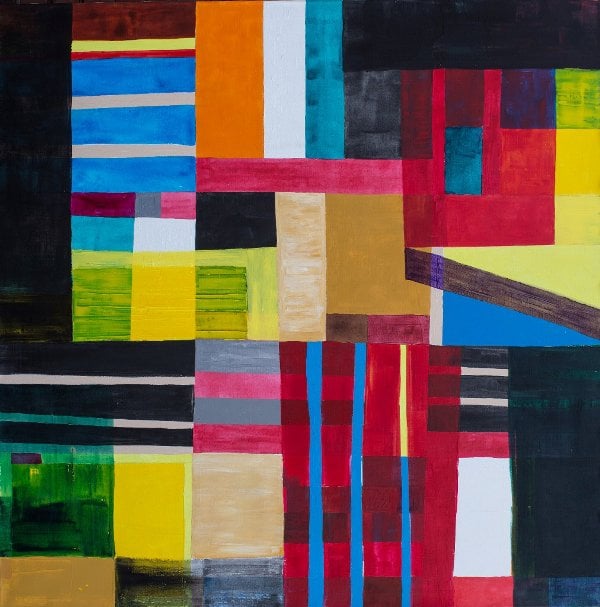
Atta Kwami, Xebubuyi (2015).
Photo: Courtesy Howard Scott Gallery.
6. Atta Kwami at Howard Scott, through April 4.
In “Kuduo,” Ghanaian artist and writer Atta Kwami presents a cohesive and lively group of recent abstract oil paintings. The exhibition’s title refers to an Asante brass vessel in which personal treasures are stored. Indeed, the layering of colorful geometric forms arranged in each of these subtly dynamic, almost architectonic compositions suggests the unfathomable depth of a container filled with personal and emotional resonance.
Several large works, such as Kahina, approximately six-by-four feet, consist of stacks of colorful rectangles that recall building blocks of some towering edifice. The geometric forms in Xebubuyi and Amu more closely resemble woven cloth or textile patterning, like those of Kente cloth, traditionally hand-woven in Ghana. Kwami, who is the author of Kumasi Realism: 1951-2007, a seminal book on African modernism, likens the forms in his paintings to individualized maps of places and experiences.
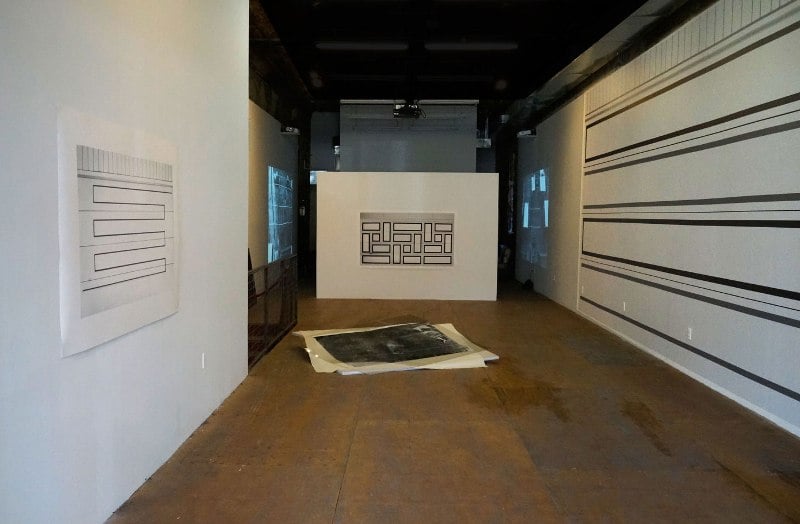
Installation view, Joy Episalla, “Street View Rear Window,” 2015;
Photo: Courtesy Participant Inc.
7. Joy Episalla at Participant Inc., through April 12.
The unlikely source material for “Street View Rear Window,” an elegant exhibition of recent photographs, sculptures and a video installation by Joy Episalla, is a series of images of garage doors the New York artist shot in Sun City, Arizona in 1989. Using the notion of a garage as a transitional space from the street to an interior, and its door as a metaphorical allusion to a camera shutter, Episalla, produced large-scale black-and-white photographs, which resemble austere minimalist paintings or drawings. One of these works spans 39 feet across a gallery wall.
Aerial View 3, an impressive sculptural piece placed in the center of the gallery, features a large photogram lying atop a pile of Plexiglas sheets and canvas. Episalla physically engages viewers in a rear gallery by enveloping them in the midst of a 3-channel video projection. The images projected on the walls consist of aerial shots of the dismantling of a street market in Paris. Like the other works in the show, the set-up seems simple, but the perceptual workout Episalla offers is formidable.
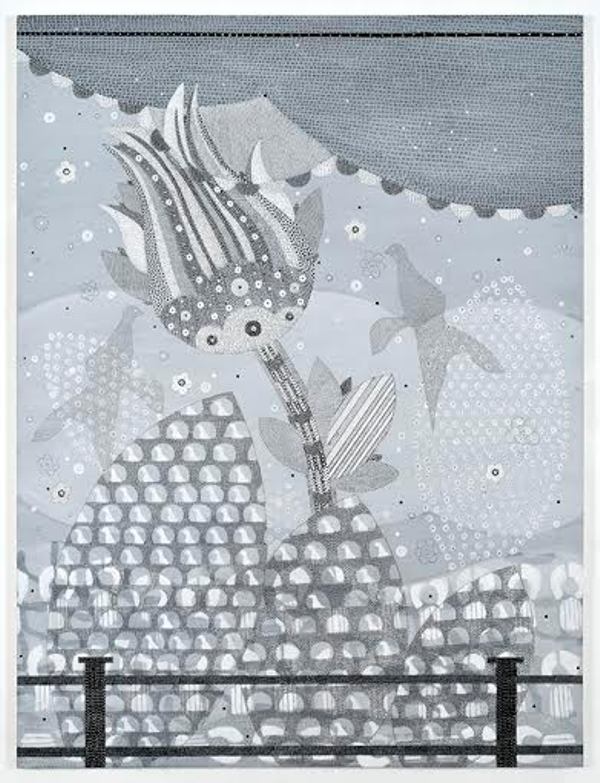
Glenn Goldberg, Place (2015).
Photo: Courtesy Betty Cuningham Gallery.
8. Glenn Goldberg at Betty Cuningham, through April 4.
In “all day,” a show of recent large-scale works, New York painter Glenn Goldberg, known as a consummate colorist, has, as he did in his previous exhibition, abandoned color altogether. It is amazing, though, how it manages to achieve with only shades of gray and touches of white the complex tonal relationships and subtle spatial depth that one usually associates with color.
In these sumptuous and labor-intensive works, the imagery is simple—mostly derived from childhood toys, flowers and fish, which Goldberg abstracts into tight compositions that often resemble needlepoint, tapestry, or a refined form of Australian aboriginal painting. Tapestry does, in fact, recall a Persian carpet in its mesmerizing patterns of floral and vegetal shapes, as well as in its velvety surface texture. A particularly dense and resplendent grisaille composition, Place is an aquatic scene featuring a fabulous, stylized fish navigating some otherworldly sea.
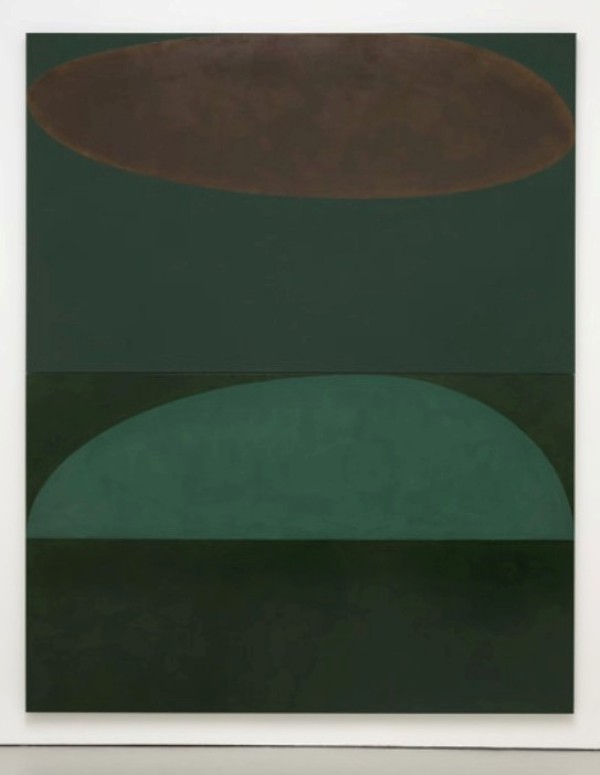
Suzan Frecon, terre verte (2014).
Photo: Courtesy David Zwirner.
9. Suzan Frecon at David Zwirner, through March 28.
Philadelphia-born New York painter Suzan Frecon is in top form in this show of recent monumental abstract canvases. The exhibition’s title, “oil paintings and sun,” underscores the importance of nature and natural light in creating as well as viewing the works. Illuminated only by the gallery’s skylights, the rich, earthy colors and varied textures of these spare compositions, some multi-panel pieces up to nine feet tall, seem to shift as one moves through the space.
Frecon favors a vocabulary of simple organic forms set against monochrome grounds, of analogous or sometimes contrasting colors, and a play of matte and gloss surface textures. Especially prevalent here is a bifurcated oval shape that recurs in a number of canvases. In tones of brown and deep red, these forms often seem to allude to earthen mounds or mountains. In embodiment of red (orange) (2013), the orange oblong semicircle in the upper portion of the canvas recalls the image of a setting sun. A particularly arresting painting, terre verte (2014), features luminous expanses of deep forest greens and sea-foam blue. This work, like a number of others in the show, evokes the experience of nature without relying on descriptive elements.
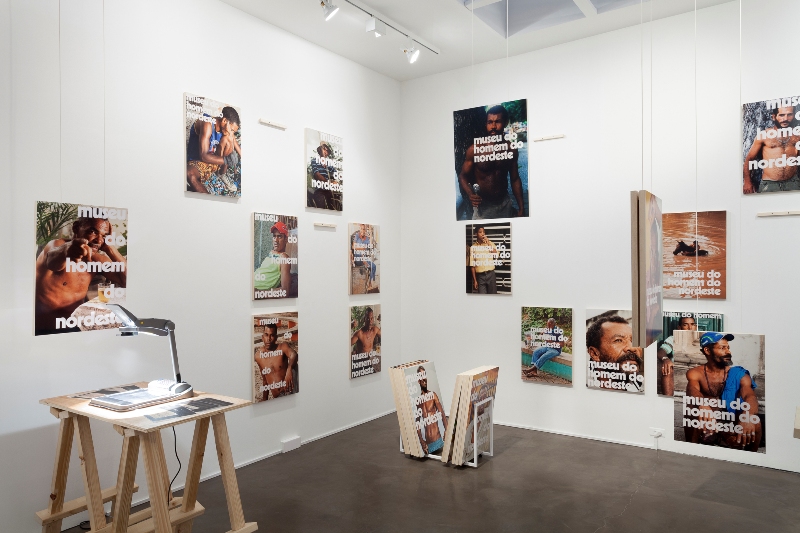
Installation view, Jonathas de Andrade (2015).
Photo: Courtesy Alexander and Bonin
10. Jonathas de Andrade at Alexander and Bonin, through April 11.
Brazilian artist Jonathas de Andrade, 33, has gained significant attention in New York recently for his work included in “Under the Same Sun: Art from Latin America Today,” at the Guggenheim Museum last year, and his appearance in the 2012 New Museum Triennial. In this, his debut solo exhibition in North America, de Andrade shows considerable promise. Here, he presents several new installations and a revamped version of Posters for the Museum of Northeast Man, which he introduced in the Guggenheim show. Based on theorist Gilberto Freyre’s concept of “racial democracy,” this interactive piece invites viewers to act as curators. Visitors can select pictures mounted on wood panels and hang them on supports attached to the gallery walls. These images of buff male laborers, accompanied by blocky, slogan-like texts in Portuguese, appear in the form of an advertising campaign.
The thread of homoeroticism in this work continues in several of the more recent installations featuring photos and text, which also have the feel of exhibits one might find in an anthropological museum. One outstanding photo piece, Sugar Cane ABC, shows a series of images of workers on a sugar plantation in Brazil forming letters of the alphabet with tall sugar cane stalks. Full of wit and humor, de Andrade’s work draws on his Brazilian heritage while exploring ideas with potentially universal appeal.
David Ebony is contributing editor of Art in America and a longtime contributor to artnet.
For more of David Ebony’s top picks, see: